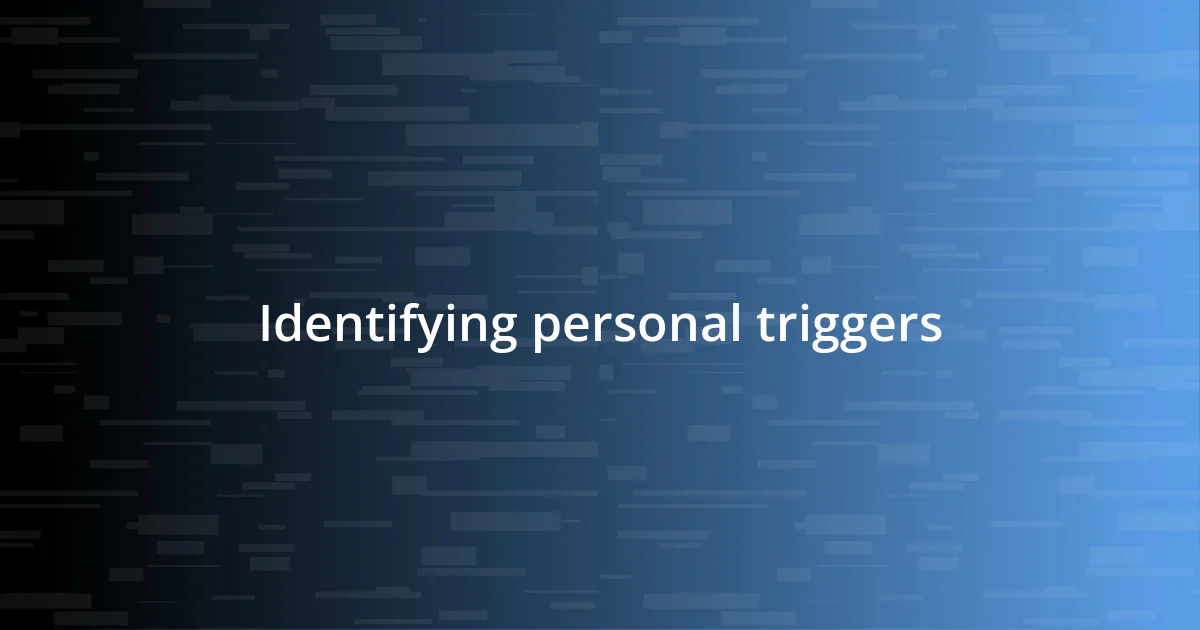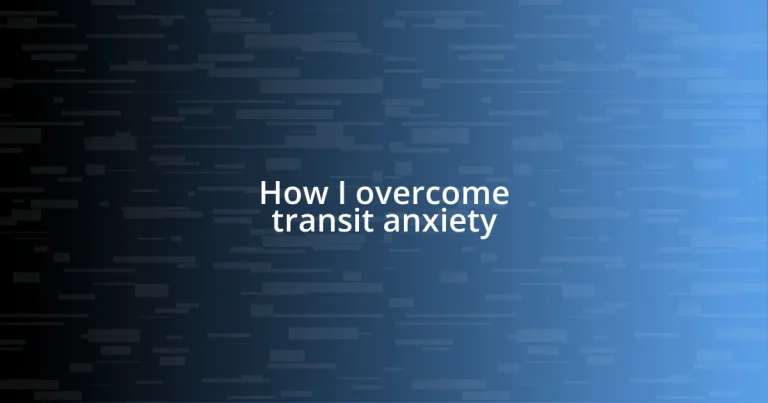Key takeaways:
- Identifying personal triggers, like crowded spaces and delays, is crucial for addressing transit anxiety effectively.
- Developing coping strategies, such as mindfulness and detailed travel plans, can significantly alleviate anxiety during commutes.
- Utilizing support systems and setting realistic travel goals fosters a sense of control and encourages progress in managing anxiety.

Understanding transit anxiety
Transit anxiety is a real challenge that many people face, and it manifests in various ways. Personally, I remember feeling that tight knot in my stomach whenever I had to board a crowded subway during rush hour. It’s that overwhelming sensation of uncertainty that makes you question, “What if I get lost?” or “What if I can’t find a seat?” These questions can spiral into a wave of panic, making the prospect of traveling seem daunting.
This anxiety often stems from a lack of control. When we’re in transit, we rely on schedules and others to reach our destinations, which can feel incredibly unsettling. I once missed a train, and the panic that followed was intense. Suddenly, I found myself grappling with feelings of vulnerability and helplessness—emotions that tapped into deeper fears rooted in my past travel experiences.
Understanding transit anxiety means recognizing its triggers and acknowledging that it’s more common than many realize. Have you ever felt tense while waiting for a bus, unsure if you’ll make it to your appointment on time? That feeling of being in limbo is something I’ve experienced too, often making me wonder how many others share this struggle. When we talk openly about it, we begin to demystify those feelings and, in a way, cut them down to size.

Identifying personal triggers
Identifying personal triggers is essential in tackling transit anxiety effectively. I recall a time when I felt particularly uneasy stepping onto a bus. The combination of close quarters and unfamiliar faces made my heart race. It became clear to me that certain situations, like crowded environments or unplanned delays, heightened my anxiety levels. By pinpointing these specific moments, I’ve been able to approach them with a more proactive mindset.
To help you identify your own triggers, consider these common situations that might evoke anxiety:
- Crowded spaces, like busy train stations or buses during peak hours
- Uncertainty in travel plans, such as missed connections or unclear maps
- Experiences of feeling lost or disoriented in unfamiliar areas
- Waiting for transportation, especially when time is of the essence
- Conversations or interactions with strangers that feel overwhelming
By reflecting on these instances and how they affect you, you can gain a clearer understanding of your anxiety’s roots. Recognizing these emotions can be the first step towards feeling more grounded during your journeys.

Developing coping strategies
Developing coping strategies is crucial for managing transit anxiety effectively. Over time, I’ve learned that even small adjustments can make a significant difference in how I handle my feelings when commuting. For instance, I often carry calming distractions, like a good book or soothing music, which helps me shift my focus away from anxious thoughts. I recall one particularly stressful journey where I felt overwhelmed, and diving into an engaging story allowed me to escape the moment.
Another strategy I’ve found effective is practicing mindfulness techniques. When waiting for a train or bus, I take a moment to breathe deeply and center my thoughts. Closing my eyes and focusing on my breath often brings me back to the present and eases the tension in my body. You might think this is simple, and it is, but I’ve found its power in those tense moments during my commute—like when I had to take a long-distance bus. The sudden realization that I couldn’t check my schedule became manageable with some conscious breathing.
Creating a travel plan before a journey can also ease uncertainty and help me feel more in control. This approach involves mapping out routes, checking schedules, and allowing extra time for potential issues. I remember traveling to an important event and spending time preparing a detailed itinerary, which significantly reduced my anxiety. Knowing what to expect turned what could have been a panic-inducing trip into a structured, much calmer experience.
| Strategy | Description |
|---|---|
| Calming distractions | Utilizing books or music to divert focus from anxious thoughts. |
| Mindfulness techniques | Practicing breathing exercises to stay present and alleviate tension. |
| Detailed travel plans | Preparing routes and schedules to enhance feelings of control. |

Practicing mindfulness techniques
When I first attempted mindfulness techniques, I was skeptical; could simply focusing on my breath really ease tension? One afternoon, while stuck on a crowded subway, I decided to give it a try. I closed my eyes, inhaled deeply, and envisioned each breath washing over me like a tide. Suddenly, the overwhelming noise of the city shrank, and with each exhale, I felt my anxious thoughts loosening their grip.
The beauty of mindfulness lies in its versatility. I can practice it anywhere—whether waiting in line or riding on a bumpy bus. I once found myself in a tense situation while navigating an unfamiliar airport. Instead of succumbing to anxiety, I took a moment to regain control. I paused, focused on my breath, and centered my thoughts. It was astonishing; the chaos around me faded as I became more attuned to my immediate surroundings. Isn’t it incredible how something so simple can be so powerful?
Each time I practice these techniques, I notice a shift in my mindset. Instead of dreading my next commute, I look at it as a chance to cultivate stillness amidst the bustle. This practice transforms anxiety into a moment of mindfulness—reminding me that I can find serenity, even on the busiest of streets. Have you tried incorporating mindfulness into your own routine? I’d encourage you to explore the potential of these techniques and see how they can improve your travel experiences.

Utilizing support systems
Utilizing a support system has been a game changer for me in managing transit anxiety. I remember the first time I confided in a friend about my struggles; their understanding and encouragement gave me the confidence to tackle those anxiety-filled trips. It made me realize that sharing my feelings not only lightened the emotional load but also opened a door to strategies and support I hadn’t considered before. Have you ever talked about your anxieties with someone close? It can feel liberating.
I’ve also found that surrounding myself with supportive peers during my commutes greatly reduces my anxiety. Whether it’s a friend who rides with me or friends I’ve made through online groups, having company transforms the experience. I recall one particularly nerve-wracking trip where a friend joined me. We chatted and laughed, making the journey feel lighter and more manageable, almost as if the burdens of transit melted away. It’s fascinating how companionship can provide comfort, isn’t it?
Another effective avenue is seeking guidance from professionals, such as therapists or support groups. I once attended a small group focused on managing anxiety, and it was so refreshing to hear others share similar worries. The shared experiences fostered a sense of community and understanding I didn’t know I needed. It’s empowering to know that you’re not alone—have you considered reaching out for professional support? It’s a step that can open up entirely new ways to approach your anxiety.

Setting realistic travel goals
Setting realistic travel goals is essential for anyone grappling with transit anxiety. In my experience, aiming for smaller, achievable objectives often provided me with a sense of accomplishment. For instance, I recall a time when I simply decided to take a five-minute walk to the next bus stop, instead of jumping straight onto a crowded train. That simple commitment allowed me to adjust my expectations and gradually ease into longer rides.
Once, I set a goal to travel to a nearby city, but instead of making it an all-day adventure, I broke it into smaller parts. I planned to take a single train to the outskirts and spend just an hour exploring. This approach helped me manage my anxiety because I knew I wasn’t committed to a lengthy journey. I wrapped up my trip feeling proud of myself and engaged with my surroundings, reminding me how vital it is to start small. Have you thought about how breaking down your travel plans might help ease your discomfort?
Moreover, keeping a travel journal proved invaluable. I documented my journeys, noting my feelings before, during, and after each trip. This reflection offered me insights into my progress, showing me that even the most minor steps were noteworthy. I found it uplifting to see my own growth over time; it transformed my mindset from fear to one of anticipation. What if you started recording your travel goals and feelings? You might discover a newfound appreciation for the seemingly ordinary moments.

Evaluating progress and adjusting methods
Tracking my progress in managing transit anxiety opened my eyes to how I was evolving. Initially, I noted every small win, like making it to the bus stop without a panic attack. There were days when even that felt monumental. Reflecting on these moments helped me appreciate my growth and refine my approach. Have you ever taken the time to recognize your progress? It can be a powerful motivator.
Adjusting my methods became a natural part of my journey. I learned that what worked one week might not be as effective the next. For instance, when I noticed my anxiety creeping back, I switched from listening to upbeat music during my commutes to engaging in a mindfulness exercise instead. This simple change brought me back to a state of calm. Isn’t it fascinating how being flexible can yield such different results?
To truly gauge my progress, I began to seek feedback from my support network. I asked my friend how they perceived my changes and what they noticed about my anxiety levels over time. Their insights often illuminated shifts I hadn’t realized, providing validation that my efforts were paying off. Have you considered getting an outside perspective on your journey? Sometimes those closest to us can see our growth better than we can.














